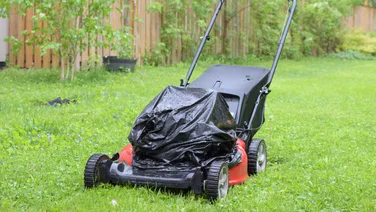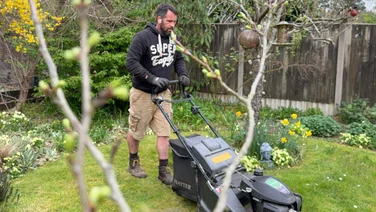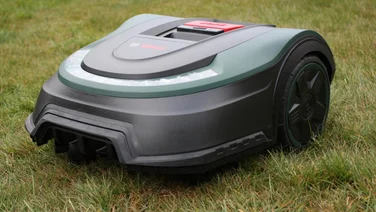To help us provide you with free impartial advice, we may earn a commission if you buy through links on our site. Learn more












- Increased cutting area
- Good performance
- Replaceable battery
- More expensive than its predecessor
- Some features cost extra
The Worx Landroid S400 WR184E is the natural successor to the Landroid S300 WR130E. In fact, except for the product name, the two mowers appear to be indistinguishable. With the S300 disappearing from retail shelves, however, and no longer available in the UK from the Worx website, the S400 is now the Worx unit you’re looking for if you want the most affordable model for a small lawn (for larger gardens, you might need to fork out a bit more cash: check out our roundup of the best robot lawn mowers for a wider selection).
If you’re concerned about the concept of rebadging an old mower, you really shouldn’t be. We gave the S300 a Best Buy award when we reviewed it and the S400 maintains everything we liked about its predecessor. However, it can now handle a larger lawn and has received a few worthy software tweaks.
Worx S400 WR184E review: What do you get for the money?
Just like the previous version, the Worx S400 WR184E is a relatively compact mower. The unit itself is identically sized at 361 x 507 x 205mm (WDH) and weighs 8kg. It has two large wheels at the back, which drive and steer the robot, and a smaller coaster at the front that keeps the base off the ground.












On the top of the robot is a large red stop button and a control panel, consisting of a monochrome LCD screen and four membrane-style buttons. There’s also a rain sensor on the top that, if it detects moisture, will stop the mower from heading out or send it home if it’s already started.












The left side of the mower has a dial for setting the height of the cutting blade, which can be adjusted in 10mm increments between 20mm and 50mm. The right side is reserved for the charging contacts, which connect to extending arms that reach out from the supplied base station.












This side-charging arrangement is unusual but all Worx’s robot mowers use it. It’s a good system, because it lets the mower roll on and off the base plate from either side, keeping the connection tower as close to the edge of the lawn as possible. The upshot is you don’t get an overgrown area inside the perimeter that the mower can’t access.
Although the only way to charge the S400 is by docking the mower, the 20v battery is easily removable from a door at the rear. It’s a standard Worx battery design that can be used across the company’s range of power tools and it can be charged outside the mower if you have a separate charger.












Also included in the box are the various bits and bobs you’ll need to connect the device. These include the cabling you’ll need to connect the charging station to an outdoor three-pin socket, 100m of perimeter wire, a load of pegs to secure it to the ground and a handful of spare parts (replacement blades and wire repair connectors).












As with the previous model, Worx offers modular upgrades, so you can add obstacle detection, virtual fences to block areas off, a Wi-Fi booster and an anti-theft device. These additions aren’t particularly cheap, though, ranging between £120 for the anti-theft alarm, up to £220 for collision detection.
Worx S400 WR184E review: Is it difficult to set up?
As with most robot lawn mowers, the Worx S400 WR184E takes a bit of setting up. You need to be able to connect the charging station to a permanent outdoor power socket, so the mower can charge every time it returns home. You also need to lay a perimeter wire around the edge of any lawn areas that you want the mower to cut.












How long this will take will depend entirely on how large and complex your lawn is, but you probably want to set aside a couple of hours for all this if you’re new to robot mowing. And the details do vary depending on the type of edge your lawn has. For instance, you can lay the wiring as close as 10cm from the edge if that edge is at the same height as the lawn – sunken paving, for instance – and this will leave a 1cm strip of uncut grass between the lawn and the path.
However, if your lawn butts up against a raised border, such as lawn edging, the recommendation is to leave a larger 26cm gap, which leaves a 17cm strip of unmowed lawn. Running up to dropped edges and water features, the suggestion is upped to a cautious 30cm, leaving 21cm untrimmed. Once the wire is laid and pegged down, all that remains is to connect the base station, switch on the power, and pop the mower on to charge.
The mower’s advanced functions can only be accessed by connecting it to your home Wi-Fi network and downloading the Worx app. Once you’ve done this, you can set up your own scheduling with two time slots available for each day of the week.












Alternatively, switch on Auto Schedule and the app will set up a schedule just for you, depending on the size of your lawn, the soil type and the grass species. It will even measure it for you, if you pace it out while the app is switched to measuring mode and, if you want to tweak the schedule or increase or decrease the mowing time, you can do that in the app, too.
READ NEXT: The best robot lawn mowers to buy
Worx S400 WR184E review: How well does it mow the lawn?
Despite the fact that Worx S400 WR184E is compact, its cutting disc is actually the same size as most other robot mowers, so it isn’t any less capable. In fact, the S400 is rated for lawns up to 400m² in size (up 100m² from the previous model) and, when it came to testing it on my garden, it did a fine job.
The S400 cuts around the perimeter wire twice a week by default and leaves a neater, cleaner edge than you’d get from a drop and mow rival, such as the Lawnmaster VBRM16, which doesn’t have a perimeter wire it can follow. And sending it out for two to three hours per day on weekdays was more than enough for its random mowing pattern to cover all areas of my 100m² lawn.
Larger, more complex gardens might prove more of a challenge, however, and if there are bits it regularly misses on your garden you can use the mower’s “Multi-zone” feature to ensure more even coverage. Using this useful feature, you drop markers around the perimeter wire and assign a percentage of its mowing time to each one, the end result being it spends at least some time in each of those areas.
I spotted one thing that struck me as different to the previous iteration of this mower. With the previous model, the robot would perform a change of direction when detecting a boundary wire by stopping and rotating in place by moving both rear wheels in opposite directions.
The S400 starts turning like this but then softens the turn when it gets perpendicular to the wire, starting to roll forwards and away, rather than simply driving straight out again when it reaches the required angle.
This is a nice touch. The robot’s wheels can wear the grass down in places where they spend a lot of time and this slight tweak to how it moves away from the boundary wire should reduce the problem.
Worx S400 WR184E review: Should I buy it?
Overall I was as delighted with the Worx S400 WR184E as I was with its predecessor, the S300. It’s the robot lawn mower that delivers the very best in price/performance balance and, while it isn’t the cheapest you can buy, bear in mind that most cheaper models aren’t rated for gardens as large as the Worx is. Overall, it’s simply a brilliant robot mower.
However, it won’t be perfect for everyone. For those with even larger gardens, the Worx M500 WR165E is a better choice. This isn’t only rated for larger gardens; it also has a few different features. The best of these is its offset cutting blade, which lets it cut a little closer to the edge, leaving you with less additional trimming to do.
If you’d prefer a mower that cuts your lawn more efficiently, meanwhile, the Bosch Indego S500 covers the ground in a controlled manner, rather than cutting randomly. This means it only has to go out once and you can be sure it’s been everywhere. It’s more expensive than the Worx S400, though.
If you have a smaller garden, you can get away with a cheaper mower. The £260 Yard Force EasyMow 260B is our budget pick, and will cope with lawns up to 260m² in size. It doesn’t have all the features of the Worx but can still be scheduled using an app.
And on the subject of small gardens, if you’d rather not lay wires, the Lawnmaster VBRM16 could be for you. It can cope with grassy areas up to 100m² in size and it’s a “drop and mow” model that scans the ground ahead of itself and turns around if it runs out of grass, instead of having to rely on a perimeter wire to tell it where to stop.






